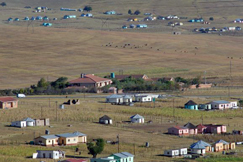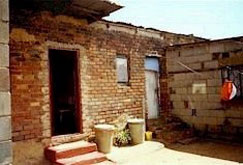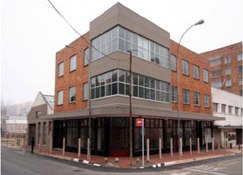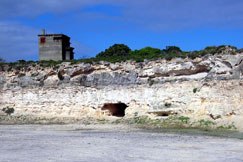Nelson Mandela
Following the Nelson Mandela trail
From the island prison where he lived for 18 years to his post-presidential archive in Johannesburg, from rural childhood scenes to a house in South Africa's busiest township, Nelson Mandela left a rich trail across the country for the discerning tourist to follow.EASTERN CAPE
Beginning life as he did in the Eastern Cape, it is only natural that the "Nelson Mandela route" begins in the province. Starting in King William's Town, which began as a missionary station in 1826, the route includes the town's Amathole Museum, which has a Xhosa Gallery, Missionary Museum and a German Settlers display. The town is also home to Black Consciousness leader Steve Biko's grave. Passing through Bhisho, the seat of the provincial government, the route moves down the N2 on to Mthatha, where the first phase of the Nelson Mandela Museum is located; it includes two other places: Qunu and Mveso. Mthatha features a display on the life and times of Mandela in the Bhunga Building of the Nelson Mandela Museum. It also displays thousands of the gifts that Mandela has received from presidents, organisations and ordinary citizens, with letters from children and bejewelled camel covers among the treasures. The Community Museum and Youth & Heritage Centre in Qunu constitutes the second phase of the museum and allows tourists to step back into Mandela's childhood. They can see what is left of his primary school, the rock he used to slide down with his friends and the graveyard where several members of his family are buried. A photographic exhibition covering significant events in Mandela's life at a thatched open air museum in Mveso makes up the third part of the Nelson Mandela Museum. The remains of the homestead where Mandela was born and raised are also nearby. There are free guided tours of all three phases of the museum, which can be arranged at the Bhunga Building in Mthatha.- Read more: Taking the Nelson Mandela Route
JOHANNESBURG
Mandela left the hills and dales of the Eastern Cape for the bright lights of Johannesburg in 1941 and found himself in the bustling township of Alexandra, about 12 kilometres northeast of the city centre. Nelson Mandela Yard Interpretation Centre When he arrived in Alexandra township, Mandela found lodging in the house of a local reverend. He later moved next door to a one-room house with no electricity or water, on the corner of Richard Baloyi and 7th Avenue. "Alexandra occupies a treasured place in my heart," he said in his autobiography Long Walk to Freedom. "[It is] a home where I had no specific house." Declared a heritage site, renovations on the yards surrounding Mandela's one-room house were started in 2004 and the area was turned into a precinct. To celebrate the centenary of Alexandra in September 2012, President Jacob Zuma visited the precinct to plant a tree. Mandela Family Museum Situated at 8115 Vilakazi Street Soweto, the Mandela Family Museum is the house Mandela returned to after his release from prison in February 1990. "It was only then that I knew in my heart I had left prison," he said in Long Walk to Freedom. "For me, no. 8115 was the centre of my world, the place marked with an X in my mental geography." It houses a variety of memorabilia, paintings, photographs and collection of honorary doctorates bestowed on Mandela from universities around the world.- Read more: Mandela Family Museum
- Read more: Mandela & Tambo's old offices restored
- Read more: Repurposed Mandela Centre to inspire
- Read more: South Africa's Constitution Hill
- Read more: South Africa's Apartheid Museum
- Read more: Liliesleaf remembered 50 years on
- Read more: Mandela the boxer in Joburg once more
KWAZULU-NATAL
Nelson Mandela Capture Site On 5 August 1962, a quiet stretch of road along the R103, about three kilometres outside Howick in KwaZulu-Natal, suddenly took on profound consequence. Armed apartheid police flagged down a car in which Nelson Mandela was pretending to be the chauffeur. So began the process that would see Mandela incarcerated for the next 27 years of his life. It has been turned into a memorial site - the Nelson Mandela Capture Site - where fifty steel column constructions align to form a portrait of Nelson Mandela against a backdrop of the Midlands' rolling hills and valleys. The sculpture was unveiled in 2012 on the 50th anniversary of the day Mandela was captured. The uMngeni municipality, in partnership the Department of Co-operative Government and Traditional Affairs, has bought the property adjacent to the capture site on the R103, and has commissioned a plan for the establishment of a museum, multipurpose theatre and amphitheatre.- Read more: Unique sculpture at Mandela Capture Site
ROBBEN ISLAND
The windswept island about 12 kilometres off the coast of Cape Town became Mandela's home for 18 of the 27 years he was imprisoned. It has since been turned into the Robben Island Museum, which was opened on 1 January 1997, and offers visitors the opportunity to delve back into the country's turbulent history. The island was declared a World Heritage Site by the United Nations Educational, Scientific and Cultural Organization in 1999. The museum offers workshops, tours and camps for adults and children. Experiences include visiting the maximum security prison where political prisoners like Nelson Mandela were held from the 1960s, the quarry mines where prisoners were forced to dig, the church and the small village where the island's main centre is situated. Daily four-hour trips are offered if the weather permits, as there is a half-hour ferry ride there and back.- Read more: Robben Island remembers

50 steel column constructions up to 9.5 metres tall come into alignment to form a portrait of Nelson Mandela against a backdrop of rolling hills and valleys at the Nelson Mandela Capture Site outside the town of Howick in KwaZulu-Natal (Photo: Jonathan Burton, Brendan Copestake)

Qunu, Eastern Cape province: Nelson Mandela grew up and went to school in Qunu (Photo: MediaClubSouthAfrica)

The Nelson Mandela yard in Johannesburg's Alexandra township (Photo: Alexandra Renewal Project)

Chancellor House in downtown Johannesburg - where Nelson Mandela and Oliver Tambo practised law in the 1950s - has been fully restored, and will soon house a law library and legal clinic (Photo: Lucille Davie, City of Johannesburg)
 The quarry on Robben Island (Photo: Rüdiger Wölk, Wikimedia Commons)
The quarry on Robben Island (Photo: Rüdiger Wölk, Wikimedia Commons)
Related links
Related articles
- Robben Island remembers
- Liliesleaf remembered 50 years on
- Mandela's 'Robben Island University'
- Honouring Mandela around the world
- The Nelson Mandela Bridge
- Repurposed Mandela Centre to inspire
- Mandela the boxer in Joburg once more
- The Robben Island Bible and the SA story
- Unique sculpture at Mandela Capture Site
- Mandela & Tambo's old offices restored
- The street where Mandela and Tutu lived
- Mandela and Gandhi on the Hill
- Taking the Nelson Mandela Route
- South Africa's Apartheid Museum
Mandela profile
Find out more about one of the great moral and political leaders of our time.








